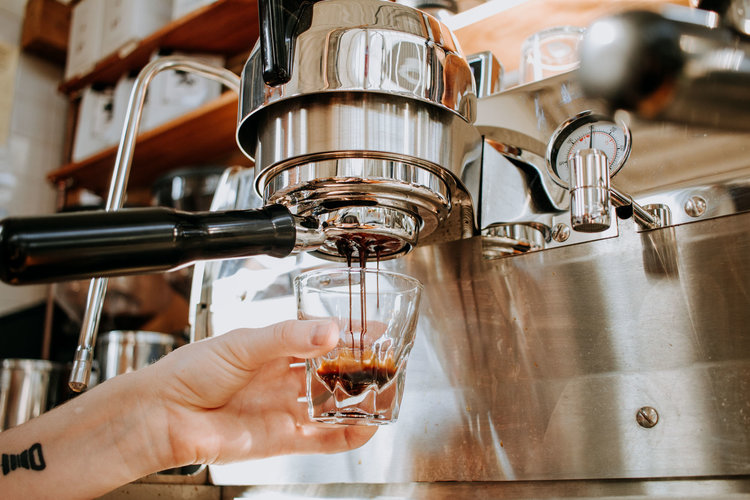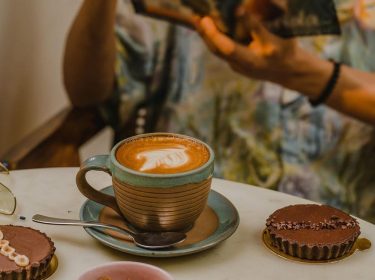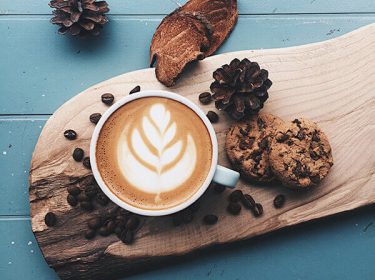
- Coffee
Espresso coffee in Italy is simply ordered as “cafe”, but it is ordered as espresso almost everywhere in the world except Italy.
This Italian espresso is a coffee staple that can be enjoyed at any time of the day.
- Cafe Doppio (double espresso)
If you want a little more coffee in your cup, order the Caffè Doppio. Just double shot the espresso and you can enjoy it in earnest.
- Cappuccino
Perhaps the most popular coffee drink in Italy, cappuccino contains milk and is made with equal amounts of Italian espresso, frothed milk and milk froth.
Cappuccino contains quite a lot of milk, so Italians drink this special type of coffee only in the morning.
If there’s one thing that sets you apart as an Italian tourist, it’s (almost) ordering a cappuccino after lunch.
There are several types of cappuccino in Italy, such as cappuccino chiaro, which has more hot milk and less foam, cappuccino secco, which is just frothed milk, and cappuccino scuro, which has less milk and more coffee than others.
You can increase or decrease the amount of coffee or milk as you like. There is also a well-chilled cappuccino “Cappuccino Freddo” that is usually served only in summer.
- Macchiato Coffee
There are two types of macchiatos in Italy, so I definitely want to specify one. If you’re looking for something bold, opt for the Cafe Macchiato.
This drink is basically espresso with warm milk added.
- 5. Cafe con panna (espresso and whipped cream)
Italian Café Con panna is one of the best Italian coffee drinks for those with a sweet tooth, served generously with homemade whipped cream.
Made with a shot of espresso, this coffee is a favorite of many coffee lovers.
There is something special about how rich whipped cream and dark espresso melt together. A delicious Italian coffee drink.
Tip:
It’s never rude to ask if the whipped cream is fresh and if you like it, it’s perfectly normal. cool whip? don’t even ask.
- Latte Macchiato
Another Italian macchiato variation is the latte macchiato. This is basically the exact opposite of a cafe macchiato.
Instead of an espresso and a shot of hot milk, a latte macchiato consists of hot milk and a shot of espresso. A macchiato is the only coffee drink with milk you can order after 11am without frowning.
- Latte Coffee
Perfect for morning coffee, this milky drink is popular with Italians and tourists alike.
But in Italy people are reluctant to order a simple “latte” because “latte” means milk. If you try it, you might end up drinking a glass of milk instead of the delicious coffee you were supposed to enjoy.
Suppose you want to order a latte instead. It’s important to note that Italian lattes are likely to be smaller than the lattes you’re used to in the United States.
- Coffee Ristretto
Cafe Ristretto is basically a stronger version of Cafe. It’s made with the same amount of beans as an Italian espresso, but with half the amount of water.
It’s basically just a sip, so it’s perfect for when you’re in a hurry but want to get a little energy.
- cafe Shekerat
Calling all iced coffee lovers! This is the Italian coffee drink for you. ‘Café Shekerat’ means ‘shaked coffee’ and that’s exactly what it is.
A talented barista brews the espresso and shakes it with ice in a cocktail shaker.
To finish off the drink’s cocktail flavor, the Café Shekerato is served in a martini-style glass.
Italians usually enjoy their Caffè Shaquerato plain, with a little sugar, or with a dash of Amaro Averna, a dark and bitter liquor. The only drawback of Café Shekerato is that it is usually only served during the warmer months. If you’re in Italy in the summer, don’t miss the opportunity to try Café Shekerato.
- Coffee Ginseng
For those who like both coffee and tea, Caffè ginseng may be the best Italian coffee.
Cafe ginseng is an Italian espresso blended with ginseng root extract. It has a unique nutty flavor that you either love or hate.
- Caffè D’Orzo
Caffè d’Orzo is one of Italy’s most unique coffees. There is actually no coffee in it.
Instead, it is made from barley, which is used in Italy as a coffee substitute.
- Marocchino
Marrocchino is a drink similar to dessert coffee. Add a shot of espresso, a few pushes of cocoa powder, and a layer of foam. And this drink looks as good as it tastes!
Marrocchino is often simply poured into a glass and finished with a pinch of cocoa powder.
So many Italians love Marrocchino that there are many variations of this Italian chocolate coffee drink.
Some versions of Marrocchino include hot chocolate powder, cinnamon, and even Nutella.
- Caffè Lungo (Long Espresso)
Café Lungo is one of Italy’s less popular varieties of coffee, similar to Café Americano, but with a stronger twist.
Café Lungo is made like an Americano with espresso and hot water. However, while a little hot water is added at the end of an Americano, Cafe Lungo uses the same water that is already in the coffee grounds.
A small but impactful change.
14 Caffè Americano
Caffé Americano is an espresso with a small amount of water added after brewing to reduce its strength.
Contrary to what many Americans think, this is not your typical American brewed coffee.
- Caffè Corretto
“Caffè corretto”, or ” corrected coffee” in Italian, refers to any type of coffee that contains alcohol. Grappa, brandy, rum, annisette, whatever.
Regional Variations of Italian Coffee Beverages
16 Caffè Anisette (Le Marche)
Caffé Anisette is an espresso-based coffee drink believed to have originated in the Marche region of Italy.
This Italian coffee drink is actually an example of Café Corretto, as it contains anisette, a liqueur flavored with anisette.
- Caffè D’un Parrinu (Sicily)
Caffè d’un Parrinu is a very special coffee. This cappuccino-like drink is found only in southern Sicily and is characterized by strong aromas of cinnamon, clove and cocoa.
- Bicerin (Piedmont)
Bicerin may sound like a medicine, but he is the traditional hot drink of Turin, one of Italy’s most famous chocolate cities. This unique coffee drink is made up of espresso, Italian chocolate and milk and is served layered in a small glass.
- Patavina (Veneto)
Patavina was born in the city of Padua in the Veneto region in the 19th century. For a while, it was actually only enjoyed by intellectuals and politicians.
As soon as you take a sip of Patavina, you’ll be amazed by the explosive mint flavor. There are notes of cocoa, cream and espresso, but it’s the mint syrup that distinguishes Patavina from other Italian coffee drinks.
- Moretta Di Fano (Le Marche)
Most coffee drinks have energy-enhancing effects, but Moretta di Fano doesn’t always have the same effect. Why, you ask? Well, moretta di fano is a kind of cafe Corretto.
In addition to espresso, Moretta di Fano also contains anise liqueur, brandy or cognac and a small amount of rum.
Flavored with lemon zest and sugar, the Moretta di Fano is a popular after-meal drink.
Usually served in small glasses, you can see layers of coffee and alcohol.
- Caffe ‘Allo Zabione (Bologna)
Enjoyed by Bologna gourmets for centuries, this unique regional coffee drink is a blend of espresso and zabaglione. We first tried it on a gourmet tour of Bologna and then went back a few more times to try it again.
The same sweet zabaglione wine pudding that we usually set aside for dessert. Eggs, sugar and a touch of wine sweetness combine with the coffee to create a truly unique Italian coffee drink.
- Granita Di Caffè (Sicily)
Visiting Sicily, you will come across another remarkable regional coffee variety. Granita di Caffè is the perfect cold coffee drink to cool down on a hot Sicilian summer day.
Granita is a semi-frozen dessert similar to sorbet, but softer. Granita di Caffè is essentially a type of coffee slush made with granita, espresso, simple syrup and topped with whipped cream.
It is sometimes served as a parfait with whipped cream on top. Really great!
Most Sicilians enjoy Granita di caffé with a snack of brioche col tuppo, one of Sicily’s most popular breads.








